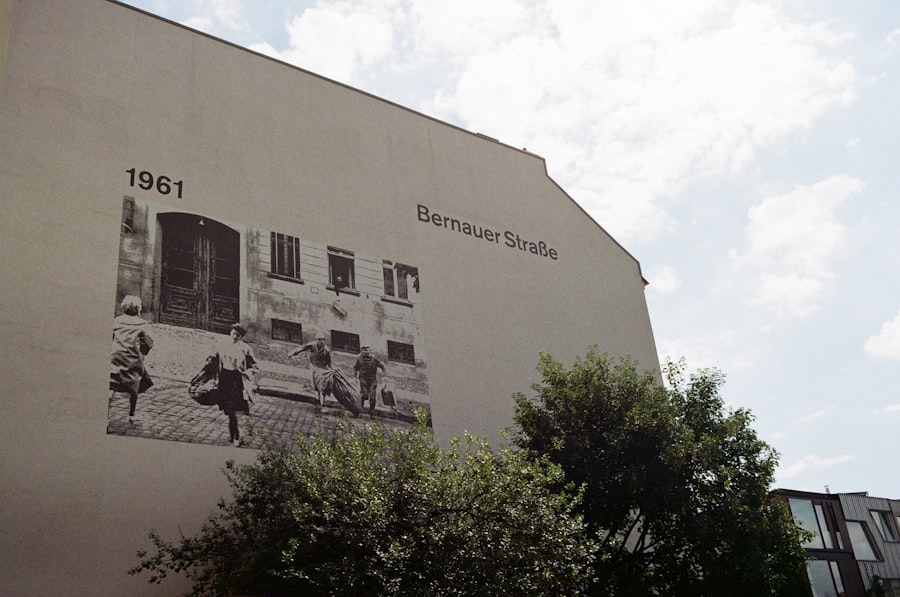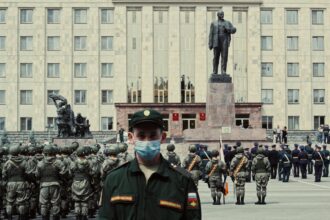Germany’s strategic diplomacy has played a pivotal role in shaping not only its own national identity but also the broader geopolitical landscape of Europe and beyond. Following the tumultuous events of the 20th century, particularly the two World Wars and the subsequent Cold War, Germany emerged as a key player in international relations. The nation’s diplomatic strategies have evolved significantly, reflecting its historical experiences and the changing dynamics of global politics.
This evolution has been marked by a commitment to multilateralism, economic cooperation, and a focus on peacebuilding, which have all contributed to Germany’s standing as a leading power in Europe. The post-war period saw Germany grappling with its identity and responsibilities on the world stage. The division of the country into East and West presented unique challenges that necessitated a nuanced approach to diplomacy.
As West Germany aligned itself with Western powers, it sought to rebuild its reputation and foster relationships that would ensure stability and security in Europe. Meanwhile, East Germany navigated its own diplomatic path under Soviet influence. This complex backdrop set the stage for Germany’s strategic diplomatic maneuvers, which would ultimately influence the course of European integration and international relations in the latter half of the 20th century.
Key Takeaways
- Germany’s strategic diplomacy played a crucial role in shaping the Cold War era and its aftermath.
- The division of Germany into East and West led to significant political and ideological differences.
- Germany’s economic miracle transformed the country into a major economic power in Europe.
- The Berlin Airlift was a pivotal moment in the Cold War, showcasing the West’s determination to support West Berlin.
- The formation of NATO and the Warsaw Pact solidified the division of Europe and heightened tensions during the Cold War.
- The Berlin Wall became a symbol of the division between East and West, separating families and communities for decades.
- Ostpolitik was a key diplomatic strategy that aimed to improve relations with Eastern European countries.
- German reunification in 1990 marked the end of the Cold War and the reunification of East and West Germany.
- Germany’s role in European integration has been instrumental in shaping the political and economic landscape of the continent.
- Germany’s Cold War victory offers valuable lessons in diplomacy, economic development, and the power of unity in the face of adversity.
The Division of Germany
The division of Germany into East and West in 1949 was a direct consequence of the geopolitical tensions that arose after World War
The country was split along ideological lines, with West Germany (the Federal Republic of Germany) aligning itself with the capitalist West, while East Germany (the German Democratic Republic) became a socialist state under Soviet control. This division was not merely a physical separation; it represented a profound ideological rift that would shape the lives of millions and influence global politics for decades. The Berlin Wall, erected in 1961, became a powerful symbol of this division, encapsulating the struggle between two opposing worldviews.

The implications of this division were far-reaching. Families were torn apart, and citizens found themselves living under vastly different political regimes. West Germany experienced a democratic revival and economic growth, while East Germany faced economic challenges and political repression.
The stark contrast between the two states highlighted the failures of communism in Eastern Europe and underscored the successes of capitalism in the West. This division not only affected domestic policies but also had significant implications for international relations, as both German states sought to assert their legitimacy on the global stage.
Germany’s Economic Miracle
| Year | GDP Growth Rate | Unemployment Rate |
|---|---|---|
| 1950 | 11.9% | 8.7% |
| 1951 | 10.5% | 7.4% |
| 1952 | 7.7% | 5.6% |
| 1953 | 4.7% | 3.2% |
| 1954 | 7.7% | 2.2% |
West Germany’s post-war recovery is often referred to as the “Wirtschaftswunder,” or economic miracle, which transformed the nation from a war-torn state into one of the world’s leading economies within a few decades. This remarkable turnaround was fueled by a combination of factors, including the Marshall Plan, which provided crucial financial aid from the United States, and the implementation of social market economy principles by Chancellor Ludwig Erhard. These policies emphasized free-market capitalism while ensuring social welfare, creating a balanced approach that fostered growth and stability.
The economic miracle not only revitalized West Germany’s economy but also played a significant role in its diplomatic relations. As West Germany became increasingly prosperous, it gained leverage in international negotiations and established itself as a key player within European institutions. The success of its economy allowed West Germany to advocate for European integration, promoting cooperation among nations as a means to prevent future conflicts.
This economic strength laid the groundwork for Germany’s eventual reunification and its central role in shaping the European Union.
The Berlin Airlift
The Berlin Airlift of 1948-1949 was a defining moment in Cold War history and showcased the strategic importance of Berlin as a focal point of East-West tensions. When the Soviet Union blockaded West Berlin in an attempt to force the Allies out of the city, it presented a significant challenge to Western powers. In response, the United States and its allies launched an unprecedented airlift operation to supply West Berlin with food, fuel, and other essential goods.
Over the course of nearly a year, aircraft flew thousands of missions, delivering vital supplies to sustain the city’s population. The success of the Berlin Airlift not only demonstrated Western resolve but also solidified West Berlin’s status as a symbol of freedom against communist oppression. It reinforced the commitment of Western powers to protect their interests in Europe and served as a catalyst for NATO’s formation.
The airlift also had profound implications for German identity; it fostered a sense of unity among West Germans who rallied around their city during this crisis. The event became emblematic of the struggle between democracy and totalitarianism, further entrenching the ideological divide that characterized the Cold War.
The Formation of NATO

The formation of NATO in 1949 marked a significant turning point in international relations and was a direct response to the perceived threat posed by Soviet expansionism. As tensions escalated in Europe, Western nations recognized the need for collective security to deter aggression from the East. NATO’s establishment provided a framework for military cooperation among member states, including West Germany, which joined in 1955 after rearming under strict conditions.
This integration into NATO not only enhanced West Germany’s security but also signaled its commitment to Western alliances. NATO’s formation had profound implications for Germany’s diplomatic posture. It allowed West Germany to play an active role in shaping European security policies while simultaneously reinforcing its ties with other Western nations.
The alliance served as a counterbalance to the Warsaw Pact, which was established by Eastern Bloc countries in response to NATO. This military alignment further entrenched the division between East and West, solidifying Germany’s position as a frontline state in the Cold War conflict.
The Warsaw Pact
In response to NATO’s formation, the Warsaw Pact was established in 1955 as a military alliance among Soviet-aligned Eastern European countries, including East Germany. This pact was intended to counterbalance NATO’s influence and solidify Soviet control over its satellite states. For East Germany, joining the Warsaw Pact was both a strategic necessity and an affirmation of its allegiance to Soviet leadership.
However, it also meant that East German sovereignty was compromised as it became increasingly reliant on Moscow for military support and political direction. The Warsaw Pact further entrenched the ideological divide within Germany and across Europe. It created an environment where military posturing became commonplace, leading to heightened tensions between East and West.
For East Germans, living under this alliance meant enduring strict control from both their government and Soviet authorities, which stifled dissent and limited personal freedoms.
The Berlin Wall
The construction of the Berlin Wall in 1961 was one of the most significant events during the Cold War and served as a stark physical manifestation of the ideological divide between East and West. Erected by East German authorities to prevent mass emigration to West Berlin, the wall became an enduring symbol of oppression and division. Its presence not only separated families but also represented the broader struggle between communism and democracy.
The wall stood for nearly three decades, during which time it became synonymous with human rights violations and state repression. The Berlin Wall also had profound implications for international relations. It solidified Berlin’s status as a flashpoint in Cold War tensions, drawing attention from around the world.
The wall’s existence prompted numerous diplomatic efforts aimed at easing tensions between East and West, including negotiations for arms control and discussions about human rights. As protests against the wall grew over time, it became clear that public sentiment was shifting against oppressive regimes, setting the stage for eventual change in Eastern Europe.
Ostpolitik
Ostpolitik, or “Eastern Policy,” emerged in West Germany during the late 1960s under Chancellor Willy Brandt as an attempt to improve relations with Eastern Bloc countries, including East Germany. This policy marked a significant shift from previous approaches that emphasized confrontation and isolation. Instead, Ostpolitik sought to engage with Eastern nations through diplomacy and dialogue, recognizing that peaceful coexistence was essential for stability in Europe.
Brandt’s efforts were characterized by groundbreaking treaties that acknowledged borders and promoted economic cooperation. Ostpolitik had far-reaching consequences for both German states and European diplomacy as a whole. It facilitated greater communication between East and West Germany, leading to increased cultural exchanges and family reunifications that had been severed by decades of division.
Additionally, this policy contributed to a broader thawing of Cold War tensions across Europe, encouraging other Western nations to adopt similar approaches toward their Eastern counterparts. Ultimately, Ostpolitik laid important groundwork for future negotiations that would culminate in German reunification.
German Reunification
The fall of the Berlin Wall in 1989 marked a watershed moment not only for Germany but also for Europe as a whole. It signaled the collapse of communist regimes across Eastern Europe and set into motion events that would lead to German reunification in 1990. The reunification process was complex and fraught with challenges; it required navigating economic disparities between East and West while addressing deep-seated social issues stemming from decades of division.
However, it also represented an opportunity for healing and reconciliation as Germans sought to forge a new national identity. The reunification process was characterized by significant political negotiations involving both German leaders and international stakeholders. The “Two Plus Four” talks included representatives from both German states along with key allies such as the United States, France, Britain, and Russia.
These discussions focused on ensuring a peaceful transition while addressing security concerns related to NATO expansion into Eastern Europe. Ultimately, reunification was achieved on October 3, 1990, marking not just a new chapter for Germany but also symbolizing hope for democratic governance across former communist states.
Germany’s Role in European Integration
In the years following reunification, Germany emerged as a central player in European integration efforts. As one of the largest economies in Europe, it took on leadership roles within institutions such as the European Union (EU) and played an instrumental part in shaping policies aimed at fostering economic cooperation among member states.
Germany’s role in European integration has not been without challenges; balancing national interests with those of other member states has often required careful diplomacy. However, its leadership has been crucial during times of crisis—such as during the Eurozone debt crisis—where Germany advocated for fiscal responsibility while also promoting solidarity among EU nations. Through these efforts, Germany has reinforced its position as a stabilizing force within Europe while continuing to champion values such as democracy, human rights, and economic cooperation.
Lessons Learned from Germany’s Cold War Victory
Germany’s experience during the Cold War offers valuable lessons about resilience, diplomacy, and cooperation in overcoming ideological divides. One key takeaway is that engagement rather than isolation can lead to meaningful change; Ostpolitik exemplifies how dialogue can bridge gaps between opposing sides even amidst deep-seated tensions. Additionally, Germany’s reunification demonstrates that healing from historical divisions requires patience and understanding—an acknowledgment that rebuilding trust takes time but is ultimately essential for lasting peace.
Furthermore, Germany’s strategic diplomacy underscores the importance of multilateralism in addressing global challenges. By actively participating in international organizations like NATO and the EU, Germany has shown how collective action can enhance security and promote stability across regions. As contemporary global issues continue to evolve—ranging from climate change to geopolitical conflicts—the lessons learned from Germany’s Cold War victory remain relevant today as nations navigate complex relationships on an increasingly interconnected world stage.
The Cold War, a period of geopolitical tension between the Soviet Union and the United States along with their respective allies, was a complex conflict that involved numerous nations and strategies. While the United States and the Soviet Union were the primary actors, Germany played a crucial role in the eventual resolution of the Cold War. The fall of the Berlin Wall in 1989 symbolized not only the reunification of Germany but also the triumph of democratic ideals over communist doctrines. For a deeper understanding of Germany’s pivotal role in the Cold War’s conclusion, you can explore this insightful article on the topic: How Germany Helped Win the Cold War. This article delves into the strategic, political, and social factors that contributed to the end of this prolonged period of tension and highlights Germany’s significant contributions to the victory of the Western bloc.
WATCH THIS! 🪖How Stolen Nazis Built Cold War Power
FAQs
What was the Cold War?
The Cold War was a period of geopolitical tension between the United States and its NATO allies and the Soviet Union and its allies, lasting from the end of World War II in 1945 until the dissolution of the Soviet Union in 1991.
How was the Cold War won by Germany?
Germany did not win the Cold War. The Cold War was ultimately won through a combination of factors, including the economic and military strength of the United States and its allies, the internal weaknesses of the Soviet Union, and the spread of democratic ideals and capitalism.
What role did Germany play in the Cold War?
Germany was a key battleground in the Cold War, with the division of the country into East and West Germany symbolizing the larger conflict between the capitalist West and the communist East. The Berlin Wall, which divided East and West Berlin, became a powerful symbol of the Cold War.
Did Germany have a significant impact on the outcome of the Cold War?
Germany’s division and subsequent reunification played a significant role in the outcome of the Cold War. The fall of the Berlin Wall in 1989 and the reunification of Germany in 1990 symbolized the end of the Cold War and the victory of the West.
What were some key events in Germany’s role in the Cold War?
Key events in Germany’s role in the Cold War include the division of the country into East and West Germany after World War II, the construction of the Berlin Wall in 1961, and the peaceful revolution in East Germany that led to the fall of the Berlin Wall in 1989.




